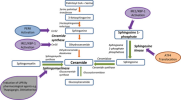I wanted to post a few recent UPR papers I found (recalling that the UPR could be tied into the ER stress Hwang found and that the wasf3 goes from the ER to the mitochondria)
1. This one caught my eye because we seem to hear about extracellular matrix, actin and fibroactin so much these days; I'm always attracted to under-studied bits of the cell that people assume are just structural but could have functional properties that are overlooked.
2024 Aug 8;187(16):4289-4304.e26. doi: 10.1016/j.cell.2024.05.057. Epub 2024 Jun 27.
The extracellular matrix integrates mitochondrial homeostasis
Hanlin Zhang 1 ,
C Kimberly Tsui 1 ,
Gilberto Garcia 1 ,
Larry K Joe 1 ,
Haolun Wu 1 ,
Ayane Maruichi 1 ,
Wudi Fan 1 ,
Sentibel Pandovski 1 ,
Peter H Yoon 1 ,
Brant M Webster 1 ,
Jenni Durieux 1 ,
Phillip A Frankino 1 ,
Ryo Higuchi-Sanabria 1 ,
Andrew Dillin 2
Affiliations
Abstract
Cellular homeostasis is intricately influenced by stimuli from the microenvironment, including signaling molecules, metabolites, and pathogens. Functioning as a signaling hub within the cell, mitochondria integrate information from various intracellular compartments to regulate cellular signaling and metabolism. Multiple studies have shown that mitochondria may respond to various extracellular signaling events. However, it is less clear how changes in the extracellular matrix (ECM) can impact mitochondrial homeostasis to regulate animal physiology. We find that ECM remodeling alters mitochondrial homeostasis in an evolutionarily conserved manner.
Mechanistically, ECM remodeling triggers a TGF-β response to induce mitochondrial fission and the unfolded protein response of the mitochondria (UPRMT). At the organismal level, ECM remodeling promotes defense of animals against pathogens through enhanced mitochondrial stress responses. We postulate that this ECM-mitochondria crosstalk represents an ancient immune pathway, which detects infection- or mechanical-stress-induced ECM damage, thereby initiating adaptive mitochondria-based immune and metabolic responses.
2. This one implicates redox imbalance. There's a million papers saying oxidative stress is rampant in ME/CFS but where does that lead? Here's one idea:
2024 Jun 7;81(1):250. doi: 10.1007/s00018-024-05286-0.
Redox regulation of UPR signalling and mitochondrial ER contact sites
Jose C Casas-Martinez 1 2 ,
Afshin Samali 2 3 ,
Brian McDonagh 4 5
Affiliations
Abstract
Mitochondria and the endoplasmic reticulum (ER) have a synergistic relationship and are key regulatory hubs in maintaining cell homeostasis. Communication between these organelles is mediated by mitochondria ER contact sites (MERCS), allowing the exchange of material and information, modulating calcium homeostasis, redox signalling, lipid transfer and the regulation of mitochondrial dynamics. MERCS are dynamic structures that allow cells to respond to changes in the intracellular environment under normal homeostatic conditions, while their assembly/disassembly are affected by pathophysiological conditions such as ageing and disease. Disruption of protein folding in the ER lumen can activate the Unfolded Protein Response (UPR), promoting the remodelling of ER membranes and MERCS formation. The UPR stress receptor kinases PERK and IRE1, are located at or close to MERCS. UPR signalling can be adaptive or maladaptive, depending on whether the disruption in protein folding or ER stress is transient or sustained. Adaptive UPR signalling via MERCS can increase mitochondrial calcium import, metabolism and dynamics, while maladaptive UPR signalling can result in excessive calcium import and activation of apoptotic pathways. Targeting UPR signalling and the assembly of MERCS is an attractive therapeutic approach for a range of age-related conditions such as neurodegeneration and sarcopenia.
This review highlights the emerging evidence related to the role of redox mediated UPR activation in orchestrating inter-organelle communication between the ER and mitochondria, and ultimately the determination of cell function and fate.
3. This one talks about how UPR can lead to intracellular communication, which is important if you're interested in things that go beyond just a few cells.
doi: 10.1016/j.canlet.2025.217613. Epub 2025 Mar 5.
Unraveling UPR-mediated intercellular crosstalk: Implications for immunotherapy resistance mechanisms
Si Lu 1 ,
Qimin Zhou 2 ,
Rongjie Zhao 3 ,
Lei Xie 4 ,
Wen-Ming Cao 5 ,
Yu-Xiong Feng 6
Affiliations
Abstract
Endoplasmic reticulum (ER) is the critical organelle that regulates essential cellular processes, including protein synthesis, folding, and post-translational modification, as well as lipid metabolism and calcium homeostasis. Disruption in ER homeostasis leads to a condition known as ER stress, characterized by the accumulation of misfolded or unfolded proteins. This triggers the unfolded protein response (UPR), an adaptive pathway mediated by three ER-resident sensors: inositol-requiring enzyme 1α (IRE1α), protein kinase R-like ER kinase (PERK), and activating transcription factor 6 (ATF6). Increasing evidence highlights sustained UPR activation in malignant and immune cells within the tumor microenvironment (TME), which promotes tumor progression and metastasis while simultaneously impairing antitumor immunity. This review explores how UPR-driven intercellular signaling influences immunotherapy resistance, focusing on the alterations occurring in tumor cells as well as in the surrounding immune environment. By providing insights into these mechanisms, we aim to highlight the therapeutic potential of targeting the UPR pathways in modulating cancer immunity.



